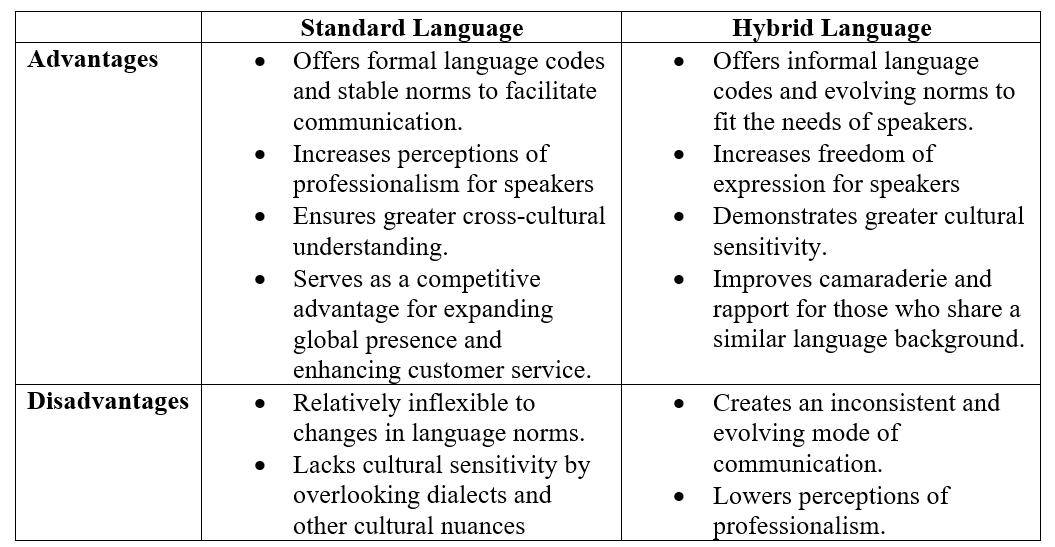Managing language dynamics at work is complex. When someone uses jargon or speaks with a different accent from the other person, misunderstanding could arise. Given the coexistence of both standard and hybrid forms of language in organisations, they must face the challenge of harnessing the benefits of diversity while mitigating its drawbacks. John Fiset and Devasheesh P Bhave outline research-supported interventions organisations could undertake to deal with the problem.
Imagine that you are an engineer working in a multidisciplinary project team for a major European commercial aircraft manufacturer. You collaborate with professionals from diverse backgrounds, including other engineers, project managers, and product-marketing specialists. In one instance, a product marketer used airline-specific jargon referring to the load factor (the ratio of passengers to available seats) of the aircraft as a crucial metric for potential buyers. However, the project managers and engineers had their own interpretation of the same jargon term that stemmed from their respective professions. They considered load factor to refer to the ratio of the aircraft’s lift to its weight. The ensuing discussion in the project team was fraught with misunderstanding until team members realised these differences in jargon use.
As the above example illustrates, managing language dynamics at work is complex. Organisations benefit from linguistic diversity. It enables effective communication with a broader customer base, improving customer service and expanding global market reach. But they also need to be cognisant that language could inadvertently result in misunderstanding. For example, in a recent survey of over 1,000 employees in eight countries on the state of workplace jargon, a majority of respondents (58 per cent) from various industries reported that co-workers overuse jargon. Moreover, 49 per cent of workers globally indicated that jargon used in meetings made them feel like their colleagues were speaking a language that they did not understand. As another example, US firms are now using artificial intelligence to mask the accent of call centre workers located overseas to minimise potential misunderstandings with their customers. For call centre workers, a purported benefit of such accent neutralisation is to reduce customer mistreatment that could occur because of their non-native accents. Accent neutralisation, however, is considered an affront to workers’ individuality and has sparked debates on privacy.
Several factors are bringing language use at work into sharp focus. These include demographic shifts, such as the rising number of people speaking languages other than English, the expansion of professions demanding specialised language due to licensing or certification requirements, and the rapid emergence of new slang terms, particularly from younger employees influenced by social media. Collectively, these elements contribute to a multi-faceted and ever evolving linguascape. The term linguascape combines “language” and “landscape,” and refers to the diverse linguistic environment that includes both standard languages, such as English and Japanese, and hybrid languages such as jargon and non-native accents. In organisations, both standard and hybrid forms of language intersect, which could inadvertently give rise to language-related misunderstanding: unintentional errors in comprehension by message receivers because of the form of language used by senders in verbal interactions.
Although it is true that people can deliberately provide false or unclear information, our focus here is not on intentional acts of misinformation, such as lying and deception, or exclusionary behaviour, including incivility and discrimination at work. Instead, our focus is on the everyday occurrences of genuine misunderstanding that unintentionally arise due to the complexities of language use within global organisations and diverse societies. Even though language-related misunderstanding is not intentional, it can still have adverse effects on employee engagement and job performance. Moreover, mistakenly attributing a genuine misunderstanding to an intentionally hostile act could unnecessarily escalate conflict and erode trust within organisations.
Regardless of intent, organisations must manage the use of both standard and hybrid languages. Standard language, marked by formal codes and stable norms (proper grammar and vocabulary), fosters professional communication. However, standard language could also be a barrier for employees who are not proficient in that language to communicate their ideas effectively. In contrast, hybrid language, with its informal codes and adaptable norms (colloquial expressions, for example), offers flexibility and freedom of expression, which can improve rapport among speakers and strengthen work relationships. However, as the example pertaining to jargon indicated, the casual nature of hybrid languages could result in misunderstanding. Given the coexistence of both standard and hybrid forms of language in organisations, managers face the challenge of harnessing their associated benefits while mitigating their associated drawbacks.
Figure 1. Comparing advantages and disadvantages of standard vs. hybrid language use at work

Considering this perspective, we undertook a study to investigate the phenomenon of language-related misunderstanding in the workplace and identify its effects. Specifically, our review is based on 122 papers from various disciplines, including management, psychology, and communications. We observe that language-related misunderstanding is a common occurrence, with potentially negative consequences for employee performance and job attitudes.
We identify three main pathways through which language-related misunderstanding influences employee outcomes: relational, emotional, and informational. The relational pathway underscores that language-related misunderstanding can strain workplace relationships and foster “us” versus “them” dynamics that can result in disunity, greater tension and conflict within the group, as people tend to gather with members of their own language subgroup. The affective pathway highlights that language-related misunderstanding can evoke intense negative emotions. For instance, employees in a Chilean organisation that mandated a change in its corporate language from Spanish to English had negative emotional reactions that increased over time. Lastly, the informational pathway emphasises the impact of how language-related misunderstanding could result in information loss. For example, a study with Indian employees found that instances where colleagues shifted between languages resulted in information loss, which decreased group productivity. Each of these three pathways can function independently or jointly, influencing how language-related misunderstanding impacts employees’ performance and attitudes.
Navigating language dynamics in the workplace presents organisations with a multifaceted challenge to harness the benefits of linguistic diversity and identify approaches to mitigate language-related misunderstanding. To achieve this crucial balance, we outline several research-supported interventions.
Managing language dynamics at work
Develop and execute a language management strategy: Organisations could develop a language strategy that integrates both standard and hybrid language competencies as factors in employee selection and promotion. In addition, offering training programs aimed at improving language competencies could help employees collaborate with those from diverse linguistic backgrounds. They could also invest in specific services and information systems that help in executing their language strategy. For instance, providing language translation services could be a vital support to employees, ensuring clear and accurate communication across languages. Furthermore, ensuring that definitions of corporate jargon, acronyms, and specialised terms are explicitly defined and readily available to all members of the organisation through channels such as the corporate intranet can minimise the potential for misunderstanding.
Provide leadership to address language gaps: Leaders can enhance communication effectiveness by fostering empathy among team members and encouraging them to consider each other’s perspectives and feelings. Additionally, promoting situational awareness, where employees are encouraged to consider the context and circumstances in which they are communicating, can enhance their ability to adapt their language use effectively and reduce the potential for language-related misunderstanding. Leaders can also work on building emotional solidarity within the team by creating an environment where team members feel connected and share a sense of common purpose. By implementing these measures, leaders can enhance awareness within their team regarding the possibility of language-related misunderstanding, ultimately working to prevent or address it more effectively.
Encourage communication redundancy to ensure understanding: To ensure clarity and minimise misunderstanding, it is important to encourage communication redundancy. For instance, if team members are communicating important information, asking them to do so in two ways, verbally and in writing, is a way to add a second communication channel in the event the first one is unclear. Another approach is to promote metacommunication: this involves holding discussions focused on overall communication practices within the workgroup. For example, workgroups can openly discuss how important information is shared within the group, identify instances of language-related misunderstanding, and generate ideas to enhance the quality of discussions. A third approach to ensuring mutual understanding is to encourage the use of plain language and promote practices such as summarising key points in a discussion or seeking clarifications through questions.
By enhancing workplace communication, these measures could foster an authentically inclusive culture. Such a culture encourages people to actively seek clarity and extend forgiveness when an unintended language-related misunderstanding occurs and helps employees thrive in linguistically diverse workplaces.
- This blog post is based on The Effects of Language-Related Misunderstanding at Work, co-authored with Nilotpal Jha, Journal of Management (2023).
- The post represents the views of its author(s), not the position of LSE Business Review or the London School of Economics.
- Featured image provided by Shutterstock.
- When you leave a comment, you’re agreeing to our Comment Policy.





